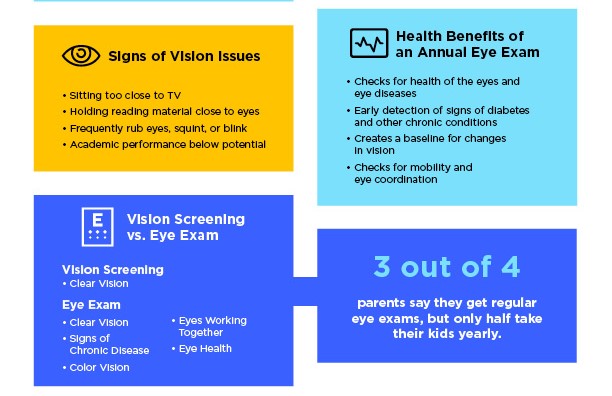According to a recent survey, 84% of patents agree that regualr eye exams help their kids do their best in school, but nearly half wait until their child complains of vision issues before taking them to the eye doctor. The problem is that children may not realize when they are not seeing properly. To help catch vision problems early, getting a comprehensive eye exam is the best way to find any changes to their vision and eye health.
Like children themselves, children's eyes are always busy. Whether at school or play, their eyes are constantly in use. But if their eyes aren't working properly, a child's development, academic performance, and even sports participation can suffer.
Vision correction needs, eye alignment, and eye infections are common issues children face with their eyes. But it's not always easy to tell when a child is struggling with their vision. Here are some tips to help spot these three common eye issues and what you should watch for whether it be your child, grandchild, neice, nephew, student, or other important child in your life.
* Refractive Errors in Children
The most common vision disorders in children are refractive errors such as myopia (nearsightedness), hyperopia (farsightedness) and astigmatism. These errors occur when light is not focused on the retina and result in blurry vision.
Myopia, or nearsightedness, means objects close up may be easy to see, but far away objects may be blurry.
Hyperopia, or farsightedness is just the opposite. Objects far away may be clear, but close objects may be hard to see.
Astigmatism occurs when the cornea or lens is irregularly shaped, causing light to bend incorrectly as it enters the eye. Astigmatism can cause blurry vision at all distances and can be especially troublesome at night when lights reflect more.
Some signs a child might have a refractive error include:
- Squinting
- Holding materials close to their face or at arm's length
- Frequent headaches
- Rubbing their eyes
Thanksfully, most refractive errors can be corrected with prescription glasses or contacts. An eye doctor can identify these vision issues and determine the prescription needed.
* Eye Misalignment
In addition to vision correction needs, some children can also experience trouble with eye focusing, eye tracking, and eye coordination. These issues can impact a chi;d's academic performance and long- term vision.
Strabismus, or crossed eyes, occur when the eye(s) turns in or out, resulting in the eyes looking in different directions. The lack of coordination in the eyes impacts depth perception and may lead to the brain ignoring input from one eye in an effort to prevent double vision. Untreated, this can lead to permanent vision loss in the eye that the brain ignores.
Once diagnosed, eye doctors may utilize glasses or contacts, special lenses, vision therapy, and, in severe cases, surgery to correct strabismus.
Amblyopia, or lazy eye, is another impairment common in children. This occurs when the brain and the eye aren't working together correctly, with the brain favoring one eye over the other.
Some signs of stravismus and amblyopia include:
- Tilting the head to one side
- Covering an eye
- Trouble with reading comprehension
- Losing their place when reading
- Frequent headaches
- Complaining of tired eyes
- An eye turning in or out (strabismus)
* Eye Infections
Children are known for sharing germs- and that includes sharing eye infections. One fo the most common eye infections in children is Conjunctivitis- commonly known as Pink Eye.
Conjunctivitis, or pink eye refers to the irritiaion of the white part of the eye from an infection or allergen exposure. Pink eye causes red, irritated, and goopy eyes. A tell-tale sign of pink eye is waking up with your eyelids stuck together from the dried mucus produced by your eyes overnight.
Conjunctivitis caused by a bacteria or virus is very contagious, and children with pink eye should be kept home until it clears up. Allergic conjunctivitis is caused by exposure to allergens and it typically not considered contagious.
It can be difficult to know which type of pink eye a child has. An eye doctor can examine the eye and diagnose pink eye and provide treatment options.
Eye Care Starts Early
Regular eye exams starting young can help keep children's eyes healthy and ensure they see their best. Call our office today to schedule a back to school eye exam for your children because good vision and good grades go hand in hand!



